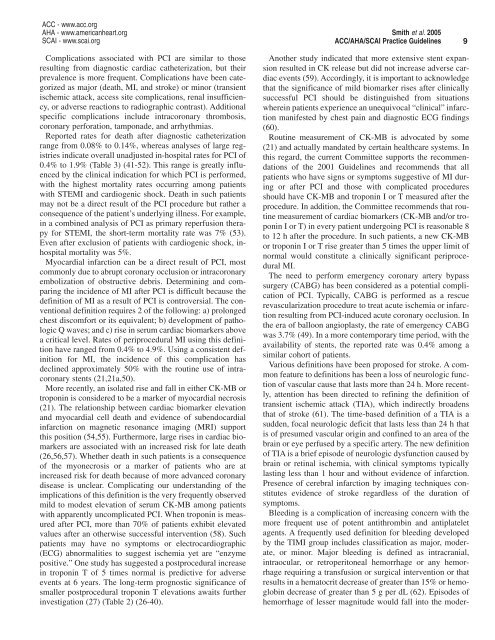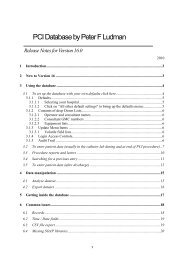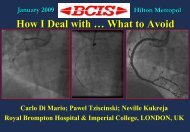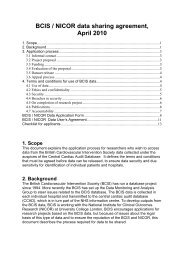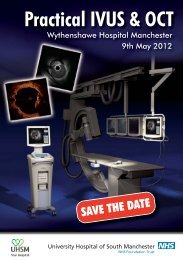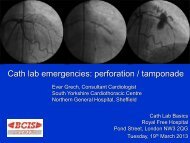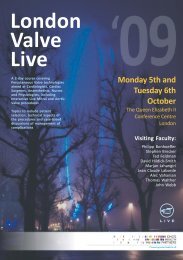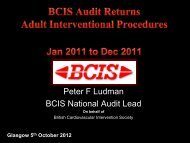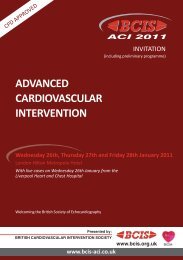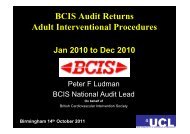Recommendations
ACC/AHA/SCAI PCI Guidelines - British Cardiovascular Intervention ...
ACC/AHA/SCAI PCI Guidelines - British Cardiovascular Intervention ...
- No tags were found...
Create successful ePaper yourself
Turn your PDF publications into a flip-book with our unique Google optimized e-Paper software.
ACC - www.acc.org<br />
AHA - www.americanheart.org<br />
SCAI - www.scai.org<br />
Smith et al. 2005<br />
ACC/AHA/SCAI Practice Guidelines<br />
9<br />
Complications associated with PCI are similar to those<br />
resulting from diagnostic cardiac catheterization, but their<br />
prevalence is more frequent. Complications have been categorized<br />
as major (death, MI, and stroke) or minor (transient<br />
ischemic attack, access site complications, renal insufficiency,<br />
or adverse reactions to radiographic contrast). Additional<br />
specific complications include intracoronary thrombosis,<br />
coronary perforation, tamponade, and arrhythmias.<br />
Reported rates for death after diagnostic catheterization<br />
range from 0.08% to 0.14%, whereas analyses of large registries<br />
indicate overall unadjusted in-hospital rates for PCI of<br />
0.4% to 1.9% (Table 3) (41-52). This range is greatly influenced<br />
by the clinical indication for which PCI is performed,<br />
with the highest mortality rates occurring among patients<br />
with STEMI and cardiogenic shock. Death in such patients<br />
may not be a direct result of the PCI procedure but rather a<br />
consequence of the patient’s underlying illness. For example,<br />
in a combined analysis of PCI as primary reperfusion therapy<br />
for STEMI, the short-term mortality rate was 7% (53).<br />
Even after exclusion of patients with cardiogenic shock, inhospital<br />
mortality was 5%.<br />
Myocardial infarction can be a direct result of PCI, most<br />
commonly due to abrupt coronary occlusion or intracoronary<br />
embolization of obstructive debris. Determining and comparing<br />
the incidence of MI after PCI is difficult because the<br />
definition of MI as a result of PCI is controversial. The conventional<br />
definition requires 2 of the following: a) prolonged<br />
chest discomfort or its equivalent; b) development of pathologic<br />
Q waves; and c) rise in serum cardiac biomarkers above<br />
a critical level. Rates of periprocedural MI using this definition<br />
have ranged from 0.4% to 4.9%. Using a consistent definition<br />
for MI, the incidence of this complication has<br />
declined approximately 50% with the routine use of intracoronary<br />
stents (21,21a,50).<br />
More recently, an isolated rise and fall in either CK-MB or<br />
troponin is considered to be a marker of myocardial necrosis<br />
(21). The relationship between cardiac biomarker elevation<br />
and myocardial cell death and evidence of subendocardial<br />
infarction on magnetic resonance imaging (MRI) support<br />
this position (54,55). Furthermore, large rises in cardiac biomarkers<br />
are associated with an increased risk for late death<br />
(26,56,57). Whether death in such patients is a consequence<br />
of the myonecrosis or a marker of patients who are at<br />
increased risk for death because of more advanced coronary<br />
disease is unclear. Complicating our understanding of the<br />
implications of this definition is the very frequently observed<br />
mild to modest elevation of serum CK-MB among patients<br />
with apparently uncomplicated PCI. When troponin is measured<br />
after PCI, more than 70% of patients exhibit elevated<br />
values after an otherwise successful intervention (58). Such<br />
patients may have no symptoms or electrocardiographic<br />
(ECG) abnormalities to suggest ischemia yet are “enzyme<br />
positive.” One study has suggested a postprocedural increase<br />
in troponin T of 5 times normal is predictive for adverse<br />
events at 6 years. The long-term prognostic significance of<br />
smaller postprocedural troponin T elevations awaits further<br />
investigation (27) (Table 2) (26-40).<br />
Another study indicated that more extensive stent expansion<br />
resulted in CK release but did not increase adverse cardiac<br />
events (59). Accordingly, it is important to acknowledge<br />
that the significance of mild biomarker rises after clinically<br />
successful PCI should be distinguished from situations<br />
wherein patients experience an unequivocal “clinical” infarction<br />
manifested by chest pain and diagnostic ECG findings<br />
(60).<br />
Routine measurement of CK-MB is advocated by some<br />
(21) and actually mandated by certain healthcare systems. In<br />
this regard, the current Committee supports the recommendations<br />
of the 2001 Guidelines and recommends that all<br />
patients who have signs or symptoms suggestive of MI during<br />
or after PCI and those with complicated procedures<br />
should have CK-MB and troponin I or T measured after the<br />
procedure. In addition, the Committee recommends that routine<br />
measurement of cardiac biomarkers (CK-MB and/or troponin<br />
I or T) in every patient undergoing PCI is reasonable 8<br />
to 12 h after the procedure. In such patients, a new CK-MB<br />
or troponin I or T rise greater than 5 times the upper limit of<br />
normal would constitute a clinically significant periprocedural<br />
MI.<br />
The need to perform emergency coronary artery bypass<br />
surgery (CABG) has been considered as a potential complication<br />
of PCI. Typically, CABG is performed as a rescue<br />
revascularization procedure to treat acute ischemia or infarction<br />
resulting from PCI-induced acute coronary occlusion. In<br />
the era of balloon angioplasty, the rate of emergency CABG<br />
was 3.7% (49). In a more contemporary time period, with the<br />
availability of stents, the reported rate was 0.4% among a<br />
similar cohort of patients.<br />
Various definitions have been proposed for stroke. A common<br />
feature to definitions has been a loss of neurologic function<br />
of vascular cause that lasts more than 24 h. More recently,<br />
attention has been directed to refining the definition of<br />
transient ischemic attack (TIA), which indirectly broadens<br />
that of stroke (61). The time-based definition of a TIA is a<br />
sudden, focal neurologic deficit that lasts less than 24 h that<br />
is of presumed vascular origin and confined to an area of the<br />
brain or eye perfused by a specific artery. The new definition<br />
of TIA is a brief episode of neurologic dysfunction caused by<br />
brain or retinal ischemia, with clinical symptoms typically<br />
lasting less than 1 hour and without evidence of infarction.<br />
Presence of cerebral infarction by imaging techniques constitutes<br />
evidence of stroke regardless of the duration of<br />
symptoms.<br />
Bleeding is a complication of increasing concern with the<br />
more frequent use of potent antithrombin and antiplatelet<br />
agents. A frequently used definition for bleeding developed<br />
by the TIMI group includes classification as major, moderate,<br />
or minor. Major bleeding is defined as intracranial,<br />
intraocular, or retroperitoneal hemorrhage or any hemorrhage<br />
requiring a transfusion or surgical intervention or that<br />
results in a hematocrit decrease of greater than 15% or hemoglobin<br />
decrease of greater than 5 g per dL (62). Episodes of<br />
hemorrhage of lesser magnitude would fall into the moder-


